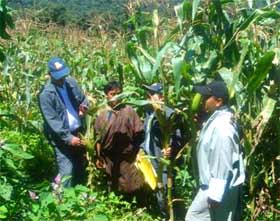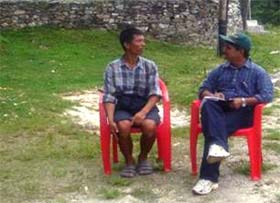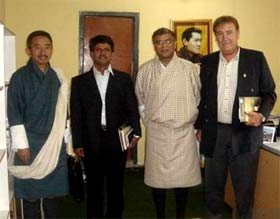CIMMYT E-News, vol 5 no. 11, November 2008
 Sandwiched between China and India, the Kingdom of Bhutan is a small country that relies on maize in a big way. But maize yields are typically low due to crop diseases, drought, and poor access to seed of improved varieties, among other reasons. CIMMYT is committed to improving Bhutan’s food security by providing high-yielding, pest-resistant maize varieties to farmers and capacity-building for local scientists.
Sandwiched between China and India, the Kingdom of Bhutan is a small country that relies on maize in a big way. But maize yields are typically low due to crop diseases, drought, and poor access to seed of improved varieties, among other reasons. CIMMYT is committed to improving Bhutan’s food security by providing high-yielding, pest-resistant maize varieties to farmers and capacity-building for local scientists.
“If there is no maize there is nothing to eat,” says Mr. S. Naitein, who farms maize on half a hectare of land in Bhutan. But it’s not easy to grow, he says, citing challenges such as animals (monkeys and wild boars), insects, poor soil fertility, drought, poor access to improved seed varieties, and crop diseases like gray leaf spot (GLS) and turcicum leaf blight (TLB).
But since planting Yangtsipa—an improved maize variety derived from Suwan-1, a variety introduced from CIMMYT’s former regional maize program in Thailand—Naitein has seen a real improvement in his maize yields. The local maize variety yielded 1,700 kilograms per hectare, whereas Yangtsipa gave him 2,400 kilograms per hectare, a 40% yield increase.
“It’s no wonder that Yangtsipa is by far the most popular improved variety among Bhutanese farmers,” says Guillermo Ortiz-Ferrara, CIMMYT regional cereal breeder posted in Nepal. “Nonetheless, many local varieties of maize still occupy large areas of the country and don’t yield well.”
Maize is a staple food in Bhutan. Many people eat Tengma (pounded maize) as a snack with a cup of tea and Kharang (maize grits) are also popular. “Among the food crops, maize plays a critical role in household food security, especially for the poor,” says Ortiz-Ferrara. About 38% of the rural Bhutanese population lives below the poverty line and some 37,000 households cultivate maize. It’s estimated that 80% of this maize is consumed at the household level, according to Bhutan’s Renewable Natural Resources Research Center (RNRRC).
Leaf us alone: CIMMYT maize varieties help combat foliar diseases
Many farmers in Bhutan have been struggling with crop diseases that cut maize yields. “The recent outbreak of gray leaf spot and turcicum leaf blight affected 4,193 households and destroyed over 1,940 hectares of maize crop,” says Thakur Prasad Tiwari, agronomist with CIMMYT-Nepal. He estimates that maize is grown on 31,160 hectares in the country.
Gray leaf spot is a devastating leaf disease that is spreading fast in the hills of Bhutan and Nepal. To deal with this threat, CIMMYT sent more than 75 maize varieties with possible resistance to GLS and TLB to Bhutan in 2007. Tapping into the resources of its global network of research stations, CIMMYT sent seed from Colombia, Zimbabwe, and Mexico that was planted in GLS and TLB ‘hot spot’ locations in the country.
Ortiz-Ferrara and Tiwari then worked with Tirtha Katwal, national maize coordinator-Bhutan, and his team to evaluate these materials for their resistance.
“Together we identified the top performing lines for gray leaf spot and turcicum leaf blight which will be excellent candidates for Bhutan’s maize breeding program,” says Ortiz-Ferrara. “We are now combining their disease resistance with Yangtsipa, because we know it is high-yielding and well-adapted to Bhutan.”
Kevin Pixley, associate director of CIMMYT’s Global Maize Program, helped to develop a detailed breeding scheme or work plan for Bhutan’s national GLS breeding program. “We want to provide capacity-building for local maize scientists so they themselves can identify and breed varieties that show resistance to crop diseases,” he says.
“We feel more confident in moving forward with the next steps in our breeding program,” said Katwal. He and his team also attended a training course on seed production, de-tasselling, and pollination given by Dr. K.K. Lal, former CIMMYT maize trainee and former chief of the Seed Quality Control Center at the Ministry of Agriculture and Cooperatives (MoAC) in Nepal.

That’s what friends are for: CIMMYT, Nepal, and Bhutan collaboration
In 2001, Bhutan began collaborating on maize research with CIMMYT-Nepal, the National Maize Research Program (NMRP) of Nepal, and the Hill Maize Research project (HMRP) funded by the Swiss Agency for Development and Cooperation (SDC) in Nepal. The terrain and agro-climatic conditions of Bhutan and the Nepalese highland are similar, meaning that technologies adapted for Nepal will likely work well in neighboring Bhutan.
CIMMYT aims to facilitate regional and national partnerships that benefit farmers. For instance, during the past 7 years CIMMYT-Nepal has worked with NMRP and RNRRP to introduce 12 open-pollinated varieties (OPVs) to Bhutan. These modern varieties yield more than the local varieties whose seed farmers save to sow from year to year. Included in these 12 OPVs were several quality protein maize (QPM) varieties; these have nearly twice as much usable protein as other traditional varieties of maize.
 “Our CIMMYT office in Nepal has assisted Bhutan with maize and wheat genetic material, technical backstopping, training, visiting scientist exchange, and in identifying key consultants on research topics such as grey leaf spot and seed production,” says Tiwari.
“Our CIMMYT office in Nepal has assisted Bhutan with maize and wheat genetic material, technical backstopping, training, visiting scientist exchange, and in identifying key consultants on research topics such as grey leaf spot and seed production,” says Tiwari.
Simply put, CIMMYT has useful contacts. For example, at the request of Bhutan’s Renewable Natural Resources Research Center (RNRRC), CIMMYT-Nepal put forward Dr. Carlos De Leon, former CIMMYT regional maize pathologist, to conduct a course on identifying and controlling maize diseases in February 2007. In September 2008, CIMMYT and HMRP also recommended two researchers (Dr. K.B. Koirala and Mr. Govinda K.C.) from Nepal’s NMRP to give a course on farmer participatory research that has been successful in the dissemination of new technologies.
“Ultimately, our goal is to improve the food security and livelihood of rural households through increased productivity and sustainability of the maize-based cropping system,” says Thakur Prasad Tiwari.
For information: Guillermo Ortiz-Ferrara, cereal breeder, CIMMYT-Nepal (g.ortiz-ferrara@cgiar.org) or Thakur Prasad Tiwari, agronomist, CIMMYT-Nepal (tptiwari@mos.com.np)
 Nutrition, health and food security
Nutrition, health and food security